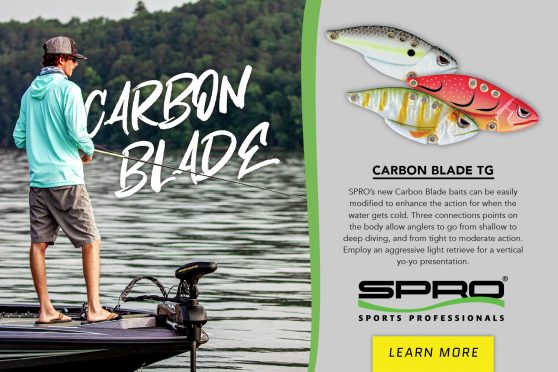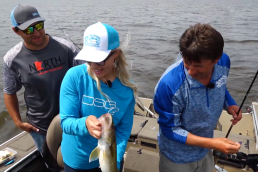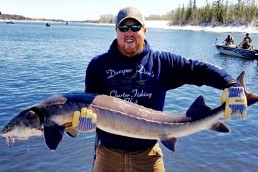Slip and Troll for March Rainy River Walleye
SHARE THIS POST
Brian ‘Bro’ Brosdahl knows a thing or two about catching trophy sized walleyes. He says March can be a golden time to target Rainy River ‘eyes, if you know how to target them.
 Some of the best ice fishing is yet to come this late winter—in March. The days are longer and the temperatures climb, creating a thaw that melts snow on top of the ice. The runoff water from the snow drains into lakes and rivers, refreshing the stale waters in the shallows. This makes March one of the best times to go ice fishing, or to hit fish on rivers as they shed their ice.
Some of the best ice fishing is yet to come this late winter—in March. The days are longer and the temperatures climb, creating a thaw that melts snow on top of the ice. The runoff water from the snow drains into lakes and rivers, refreshing the stale waters in the shallows. This makes March one of the best times to go ice fishing, or to hit fish on rivers as they shed their ice.
Where to go
Walleye season is closed on inland lakes in Minnesota during March. However, anglers are allowed to catch-and-release walleyes on the Rainy River border waters between Minnesota and Canada. The Rainy River starts at a dam below Rainy Lake in International Falls and flows west a span of 85-plus miles, through Baudette and out to the Gap on Pine Island into Lake of the Woods. The river melt-off begins in the upstream stretch below the dam, progressively extending downstream through several rapids and eventually out to the mouth of the river.
One of the more famous rapids areas is Birchdale. When the ice melts off at Birchdale, the walleye race is on. Anglers from all over the Midwest head to Birchdale when word gets out that the river is open. This is the best walleye action of the spring in Minnesota.
The Rainy River can open-up a couple miles overnight if overnight temps remain above freezing. (It does get congested if there are only a few miles or less of open river to fish.) The larger the open-river area, the more it allows anglers to cover additional sandbars, corners and current seams. I like to hit the Rainy River after it has opened up 10 to 20 miles. This definitely spreads out the river boat traffic.
What to use
There are several ways to fish the Rainy River for ice-off walleyes. Sliding along or drifting with the current using a Northland Fireball Jig and a minnow is popular. A 3/8-ounce is a good weight in current; use 1/4-ounce if the water level is down and current is slower. A Whistler Jig tipped with a fathead or rainbow minnow works extremely well, too; its flashy prop-spinner at the jig’s collar triggers more strikes in dingy or muddy water. Rainy River water is stained under normal conditions and pink, gold, sunrise and fire tiger with UV are great color choices for use on the river.
Rainy River current speeds average 2 to 3 mph. When jigging, use a sharp hop with a pause, briefly touching the bottom every few seconds to maintain good contact. In between jig strokes, keep the jig and minnow presentation off bottom about 6 inches to a foot to prevent from snagging into the sunken trees and logs. Anglers encounter lots of sandbars with most of the sunken wood and debris lodged in neckdowns and corners. There are also some rock, gravel and boulder areas along the way that hold fish.
Minn Kota’s Spot-Lock feature on Ulterra bowmount trolling motors allows anglers to “anchor” (hold in place) with a push of a button. This is a huge innovation that has helped river anglers all over the country. When you push the Spot-Lock anchor button, the motor will hold you in that spot regardless of wind, waves or boat traffic until you disengage. Nobody wants to be the boat anchor buddy on a trip who is constantly hoisting and lowering a heavy anchor with a wet rope each time you move.
Technology
While Spot-Locked, some anglers use a Northland Gum-Drop Floaters on a Roach Rig. They use a Roach sinker and a red or pink Gamakatsu Octopus style # 4 hook on a 4-foot fluorocarbon leader, baited with a big minnow such as a rainbow or sucker. The 4-foot leader allows the minnow to swim around while the boat is Spot-Locked in place. This will trigger bigger bites in cold front conditions. When a walleye strikes, allow time for the fish to turn the minnow in their mouth before setting the hook—up to approximately 10 seconds in extreme cases.
Are you enjoying this post?
You can be among the first to get the latest info on where to go, what to use and how to use it!
Another option for anchoring or Spot-Locking in place is using Baitfish-Image Spinners baited with a minnow, using a 1/2- to 1- ounce barrel sinker to keep it down on the bottom. The spinner keeps spinning in the heavy current. Watch for your rod tip to bend a bit, then lift it out of the holder and sweep-set the hook.
Drifting
My favorite way to fish the Rainy River is to slip and drift the current with a jig and minnow, moving downstream, and to troll crankbaits on my way back upstream. I keep my eye on the Humminbird Helix 12 G4 Side Imaging as I am controlled drifting downstream, marking schools of fish and potential areas to hit on my way. Then I troll upstream with my Northland Rumble B crankbaits. I choose the Rumble B cranks because their rolling, side-to-side action works great in the current to trigger slow-moving lunker Walleyes. I use the 3 3/4-inch Rumble B 09, which is the perfect size to trigger cold-water walleyes. If the fish are really biting, I will bump up to a 4 1/4-inch Rumble B 11. My favorite crankbait colors for Rainy River are natural perch, fire tiger hot perch, gold perch and silver-fluorescent chartreuse.
Troll upstream at 1.6 to 1.8 mph in current; sometimes, I will push it to 2 mph in current seams as the season progresses and water temps rise to 40 degrees. When the water hits 48 to 50 degrees, the big walleyes spawn and the bite becomes tougher.
Equipment
Braid the best fishing line to use for trolling; I like Sunline braid SX 1 in 12- or 16-pound test. It is ultra-thin and cuts the water, requiring less line out and keeping your crankbait closer to the boat. (IN 10 feet of water, about 40 to 45 feet of line.) This will send the Rumble B crankbait digging at the bottom. No dive chart is needed; just let out the line behind the boat until your lure starts hitting the bottom. Then reel up enough line so the crankbait hits bottom intermittently—not continually, creating puffs of sand which triggers walleye strikes.
St. Croix Eyecon trolling rods have a premium EVA handle, making it much easier to slide in and out of rod holders to fight lunker walleyes. I use the 7-foot to 8’ 6”, medium-power, moderate-action model for river trolling. When a walleye hits the rod, the moderate action of the rod allows the fish to grab the crankbait and load up the rod. so there’s no need to set the hook. The forgiving taper sets the hook on the fish and holds during the head shakes.
Bring a good net to land trophy fish. Frabill Trophy Haul Nets are designed to not fold over the fish and to tangle less on the crankbait. The person netting the fish should be down-current of the person fighting the fish, sweeping the net under and up while the angler is slow-rolling the reel handle. (Do not pump the rod.) Be ready with your phone or camera so you can get the fish back in the water as fast as possible; hoist the fish, photograph and release.
More Options
Other good March river walleye destinations include Missouri River in South Dakota (Lake Oahe), the Fox River in Wisconsin, and the Detroit River in Michigan—one of my favorites for giant walleyes. Don’t forget to bring your Fish Monkey Stealth Dry Tech Gloves; it can cold on the river.
Become a MidWest Outdoors Insider here!
MWO
SHARE THIS POST
Did you enjoy this post?
You can be among the first to get the latest info on where to go, what to use and how to use it!
Brian 'Bro' Brosdahl
Outdoor communicator Brian “Bro” Brosdahl lives in northern Minnesota. He is a walleye guide in the Cass Lake, Leech Lake and Lake Winnibigoshish areas. He is sponsored by Northland Fishing Tackle, Frabill/Plano, Aqua-Vu, Humminbird/Minn Kota, St. Croix Rods, Ranger Boats, and Evinrude. Guide inquiries: brosguideservice.com. Follow on social media.



